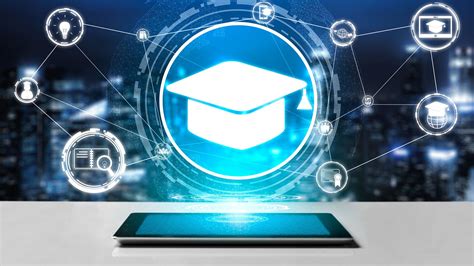In today’s fast-paced and technology-driven world, educational technologies have become an integral part of the learning process. From adaptive learning technologies to virtual reality, these tools have revolutionized the way students engage with educational material and have the potential to greatly enhance learning outcomes. In this blog post, we will explore the various ways in which educational technologies impact learning and how they can be used to maximize the learning potential of students. We will delve into the role of gamification in boosting engagement, the power of personalized learning, and how virtual reality can transform the learning experience. Additionally, we will discuss the challenges of implementing educational technologies and how to overcome them. By the end of this post, you will have a comprehensive understanding of how educational technologies can unlock the creativity, critical thinking, and essential skills of students, ultimately shaping them into well-rounded individuals ready to succeed in the modern world.
Table of Contents
The Impact of Educational Technologies on Learning
The Impact of Educational Technologies on Learning
Educational technologies have revolutionized the way we learn, making education more accessible and engaging for students of all ages. The impact of educational technologies on learning has been significant, with advancements in digital tools and resources shaping the future of education.
These technologies have enhanced the learning experience by providing interactive and customizable content, allowing students to learn at their own pace and in their own space. With the use of adaptive learning technologies, students can receive personalized learning experiences, catering to their individual needs and learning styles.
Furthermore, the integration of virtual reality in education has made learning more immersive and experiential. Students can explore historical landmarks, travel to different countries, and engage in hands-on experiences, all from the comfort of their classroom.
In addition, the use of gamification in education has transformed the way students engage with learning materials, making the process more fun and interactive. By incorporating game-like elements into the learning process, students are motivated to participate and achieve their learning objectives.
How Educational Technologies Enhance Engagement
Educational technologies have revolutionized the way students engage with learning materials. With the use of educational technologies such as interactive whiteboards, educational apps, and online learning platforms, students are able to actively participate in their learning process. These technologies provide a more dynamic and interactive learning experience compared to traditional methods.
One way in which educational technologies enhance engagement is through personalized learning experiences. With the use of adaptive learning technologies, students can receive customized learning materials and feedback based on their individual learning styles and pace. This allows for a more tailored approach to learning, which can significantly increase student engagement and motivation.
Gamification is another aspect of educational technologies that enhances engagement. By integrating game-like elements such as badges, leaderboards, and interactive quizzes into the learning process, students are motivated to participate and compete with their peers. This not only makes learning more fun but also fosters a sense of accomplishment and satisfaction.
Overall, the use of educational technologies has proven to be an effective way to enhance student engagement. By providing personalized, interactive, and gamified learning experiences, these technologies play a crucial role in keeping students motivated and actively involved in their education.
Maximizing Learning Potential with Adaptive Learning Technologies
Adaptive learning technologies have revolutionized the way students learn by providing personalized learning experiences tailored to their individual needs. By using adaptive learning technologies, educators are able to maximize the potential of each student, allowing them to learn at their own pace and in their own style. This personalized approach to learning creates a more engaging and effective learning environment, helping students reach their full potential.
One of the key benefits of adaptive learning technologies is their ability to identify each student’s strengths and weaknesses, allowing educators to provide targeted support and intervention. With the use of personalized learning paths, students can focus on areas where they need the most help and receive additional resources and guidance as necessary. This targeted approach not only maximizes learning potential, but also helps students build confidence and motivation in their academic pursuits.
Furthermore, adaptive learning technologies can provide real-time feedback and assessment, allowing educators to track student progress and make data-driven instructional decisions. By leveraging data analytics and insights, educators can better understand how students are learning and make necessary adjustments to their teaching strategies. This proactive approach to instruction ensures that students are receiving the support and resources they need to succeed, ultimately maximizing their learning potential.
In conclusion, the use of adaptive learning technologies has the power to transform education by providing personalized and targeted learning experiences. By leveraging these technologies, educators can create a more engaging and effective learning environment, while also maximizing the potential of each and every student. It is clear that the future of education lies in the hands of adaptive learning technologies, and the impact they have on student learning potential is truly remarkable.
The Role of Gamification in Boosting Learning Potential
Gamification, the use of game design elements in non-game contexts, has been shown to enhance learning potential in various educational settings. By incorporating game-like features such as points, levels, and rewards into the learning process, educators are able to engage students in a more meaningful and interactive way.
Research has indicated that gamification can motivate students to persist in their learning goals, as they are incentivized to complete tasks and achieve milestones. This increased engagement can lead to improved retention of information and a deeper understanding of the material being taught.
Furthermore, gamification can promote healthy competition among students, as they strive to earn higher scores or levels. This cooperative learning environment can encourage students to collaborate and support one another, fostering a sense of community and teamwork.
Overall, the incorporation of gamification in educational settings has the potential to transform the learning experience, making it more enjoyable and effective for students of all ages.
Unlocking Creativity and Critical Thinking with Educational Technologies
As we continue to advance in the field of education, it has become increasingly clear that educational technologies play a crucial role in unlocking creativity and critical thinking among students. By integrating various technological tools into the learning process, educators are able to provide students with a more interactive and engaging learning experience.
One of the key ways in which educational technologies enhance creativity and critical thinking is through the use of digital collaboration platforms. These platforms allow students to work together on projects, share ideas, and provide feedback in real time. This not only fosters a sense of teamwork and communication skills, but also encourages creative problem-solving and critical thinking skills.
Furthermore, adaptive learning technologies also play a significant role in unlocking creativity and critical thinking. These personalized learning tools adjust to each student’s individual needs and abilities, allowing them to progress at their own pace. As a result, students are able to explore their own interests and approach problems in unique ways, ultimately fostering a more creative mindset.
Lastly, the use of virtual reality in education has opened up new possibilities for enhancing creativity and critical thinking. By immersing students in realistic and interactive learning environments, VR technology encourages them to think outside the box and explore new perspectives, ultimately fostering innovative thinking.
Personalized Learning: Tailoring Education with Technology
Personalized learning is a method of instruction that tailors the educational experience to individual student’s needs, interests, and learning styles. This approach is made possible through the use of educational technologies that provide students with the flexibility to learn at their own pace, delve into topics that interest them, and receive targeted support when needed.
Technology in the classroom allows for the creation of personalized learning paths, where students can progress at their own speed and receive additional support in areas where they may be struggling. With the help of adaptive learning technologies, students can receive targeted feedback and resources that cater to their unique learning needs, ultimately leading to a more personalized and effective educational experience.
Furthermore, technology enables educators to easily track student progress and identify areas where students may need additional support. This data-driven approach allows teachers to adapt their instructional methods and provide students with the personalized attention they require to succeed.
Overall, the integration of technology in education has revolutionized the way students learn, allowing for a more individualized approach that caters to each student’s specific needs and learning style.
Developing Essential Skills Through Educational Technologies
Educational technologies have revolutionized the way students learn and develop essential skills. Modern technologies such as online learning platforms, educational apps, and digital resources have provided students with opportunities to improve their critical thinking, problem-solving, communication, and collaboration skills.
By integrating educational technologies into the learning process, students are able to engage with interactive content that stimulates their creativity and fosters a deeper understanding of complex concepts. These tools also enable students to work on real-world projects, enhancing their practical skills and preparing them for the demands of the future workforce.
One of the key advantages of educational technologies is their ability to cater to individual learning styles and preferences. With personalized learning platforms, students can access customized materials and resources that suit their specific needs, allowing them to develop at their own pace and focus on areas that require improvement.
Moreover, educational technologies promote self-directed learning, empowering students to take control of their education and become proactive learners. By leveraging these tools, students can acquire the essential skills necessary for success in the 21st century, ultimately shaping them into well-rounded, adaptable individuals.
Harnessing the Power of Virtual Reality for Learning
Virtual reality (VR) has revolutionized the way we learn and experience the world around us. With its immersive and interactive nature, VR has the power to transport students to different places, times, and even dimensions, providing them with a unique and memorable learning experience that cannot be achieved through traditional methods.
One of the key advantages of VR in education is its ability to make learning more engaging and enjoyable. By allowing students to interact with virtual environments and objects, VR can stimulate their curiosity and creativity, leading to a deeper understanding and retention of knowledge.
Moreover, VR can be a powerful tool for personalized learning, as it allows students to learn at their own pace and in their own way. Whether it’s exploring historical landmarks, dissecting virtual organisms, or solving complex mathematical problems, VR provides a flexible and adaptive learning environment that caters to individual interests and abilities.
Another aspect of VR’s potential for learning lies in its ability to promote collaboration and communication. By creating shared virtual spaces, VR enables students to work together on projects, engage in discussions, and even participate in immersive simulations that require team effort and communication skills.
Promoting Collaboration and Communication with EdTech
In today’s fast-paced and interconnected world, collaboration and communication are essential skills for success in both the academic and professional realms. This is where Educational Technologies come into play, offering a wide range of tools and platforms designed to foster collaboration and communication among students, educators, and professionals.
One of the key benefits of using EdTech to promote collaboration and communication is the ability to connect individuals from diverse geographical locations. Through video conferencing, real-time messaging, and online collaboration tools, students and professionals can work together on projects and share ideas regardless of their physical location.
Furthermore, EdTech provides opportunities for interactive and engaging communication through discussion forums, social media platforms, and collaborative workspaces. This not only enhances the learning experience but also cultivates important communication skills that are essential in today’s digital age.
By leveraging Educational Technologies to promote collaboration and communication, educators can create a more dynamic and interactive learning environment that prepares students for the demands of the modern workforce. Additionally, professionals can utilize these tools to seamlessly collaborate on projects, share knowledge, and communicate effectively with their peers.
Overcoming Challenges in Implementing Educational Technologies
Implementing educational technologies in the classroom can be an extremely beneficial but often challenging endeavor for educators and school administrators. One of the main challenges that must be overcome is the initial resistance to change from both educators and students.
Another challenge is the lack of adequate training and support for teachers to effectively integrate educational technologies into their lesson plans and curriculum. Without proper training, educators may struggle to utilize the full potential of educational technologies to enhance the learning experience for their students.
Furthermore, there may be financial constraints that prevent schools from acquiring the necessary educational technologies and infrastructure to support their implementation. This can hinder the adoption and integration of these technologies into the classroom.
Lastly, overcoming the challenge of addressing privacy and security concerns surrounding the use of educational technologies is crucial. Ensuring the safety and protection of student data and information is paramount in the implementation process.





